What Makes an Effective Leader? Leadership Code 2.0
An individual leader makes good things happen. And a leadership capability throughout an organization sustains long-term success.

What Makes an Effective Leader? Leadership Code 2.0

Few doubt that leaders matter and that leadership matters more. An individual leader makes good things happen. And a leadership capability throughout an organization sustains long-term success.
About ten years ago, Norm Smallwood, Kate Sweetman, and I did a meta-analysis of the views of leadership experts to define what effective leaders know and do. This work resulted in The Leadership Code book (2009) and identified five areas or domains of effective leaders and leadership. In the last decade, we have assessed and developed tens of thousands of leaders to improve in these five domains.
Without question, in the last decade, we have also seen enormous change in the context of business, including social expectations, technological disruption, economic realignment, political shocks, environmental sensitivity, and demographic evolution (see STEPED logic). We know from the seven rounds of our HR competency studies that external changes in the context of business require evolving HR competencies. For leadership, we also believe that competencies for effective leaders need to evolve to meet changing business needs. We see this evolution as a pivot more than a shift. Shift means leaders move from skills A, B, and C to D, E, and F. Pivot means leaders continue to do A, B, and C and also develop skills D, E, and F. So, what are the new skills required of leaders given the changing business context?
To answer this question, we did another meta-analysis. We used the same methodology we used for developing the Leadership Code 1.0 by seeking input from 29 thought leaders, reviewing latest leadership research, and running workshops or focus groups on emerging leadership requirements. As we did this work, we reaffirmed the importance of the original five domains of leadership, and we generated a rather extensive list of evolving required leadership competencies. We worked to prioritize this list to the one or two most critical competencies in each domain that leaders need to succeed to deliver value. These emerging competencies build on the Leadership Code 1.0, just as you might expect each successive launch of Microsoft Word would build on and evolve from previous versions.
Based on our research, interviews with thought leaders, and RBL Institute members’ comments, we have updated each of the five code domains. The numbers associated with the new competencies in the Leadership Code 2.0 model reflect the relative importance of these skills to leadership success based on thought leader comments and interviews with other key leaders (10 is high and the report only scores 6 or higher).
Strategist: Shape the Future
Strategists answer the question, “Where are we going?” and make sure that those around them understand the direction as well. They not only envision a future but also create it. Moving forward, the future of work requires Strategists to think outside-in where internal organization actions should create value for external organization stakeholders (customers, investors, communities, etc.). For example, quality of leadership should be connected to investor value, as we have discussed in The Leadership Capital Index. In addition, in an increasingly complex world, Strategists need to find simplicity on the other side of complexity.
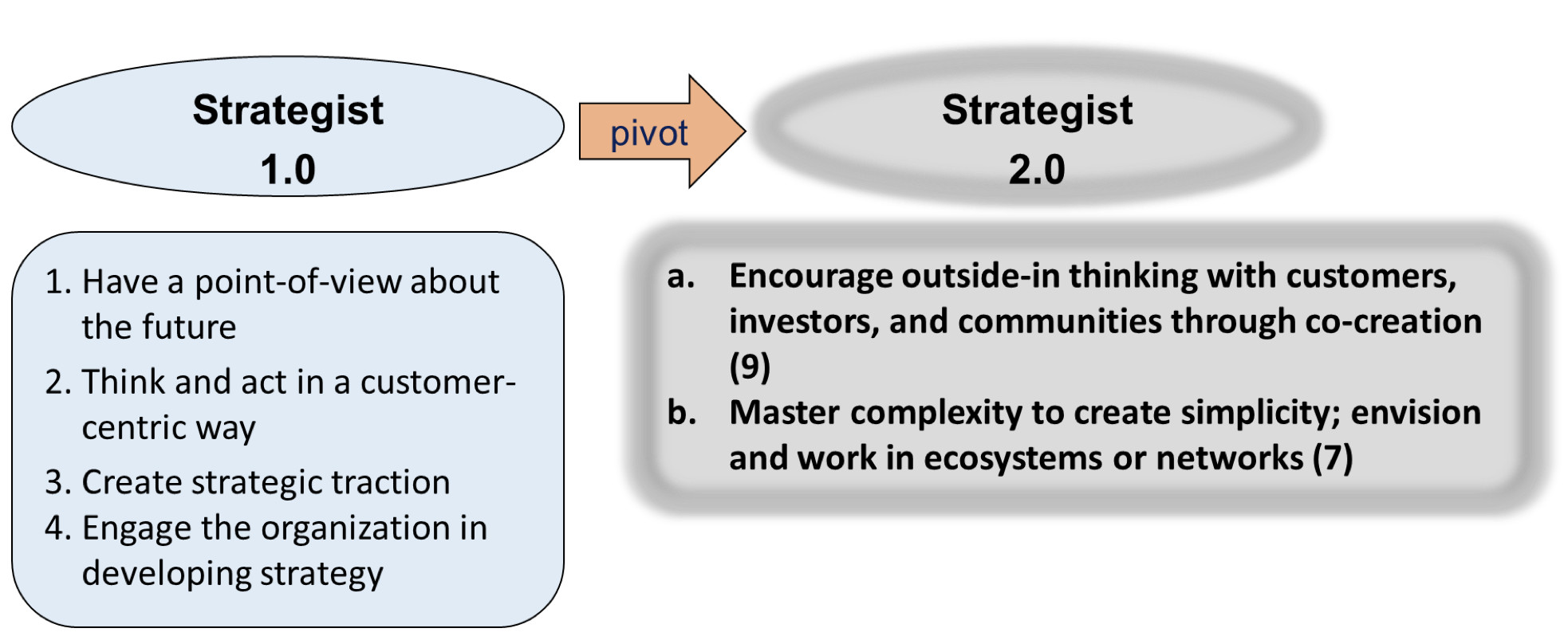
Executor: Make Things Happen
Executors focus on the question, “How will we make sure we get to where we are going?” Executors translate strategy into action. To execute for the future, today’s leaders need to take risk without being reckless by both increasing variance (experimenting, trying new things) and predictability (learning from experience). Leaders also need to focus their attention and prioritize the right work to deliver top results.
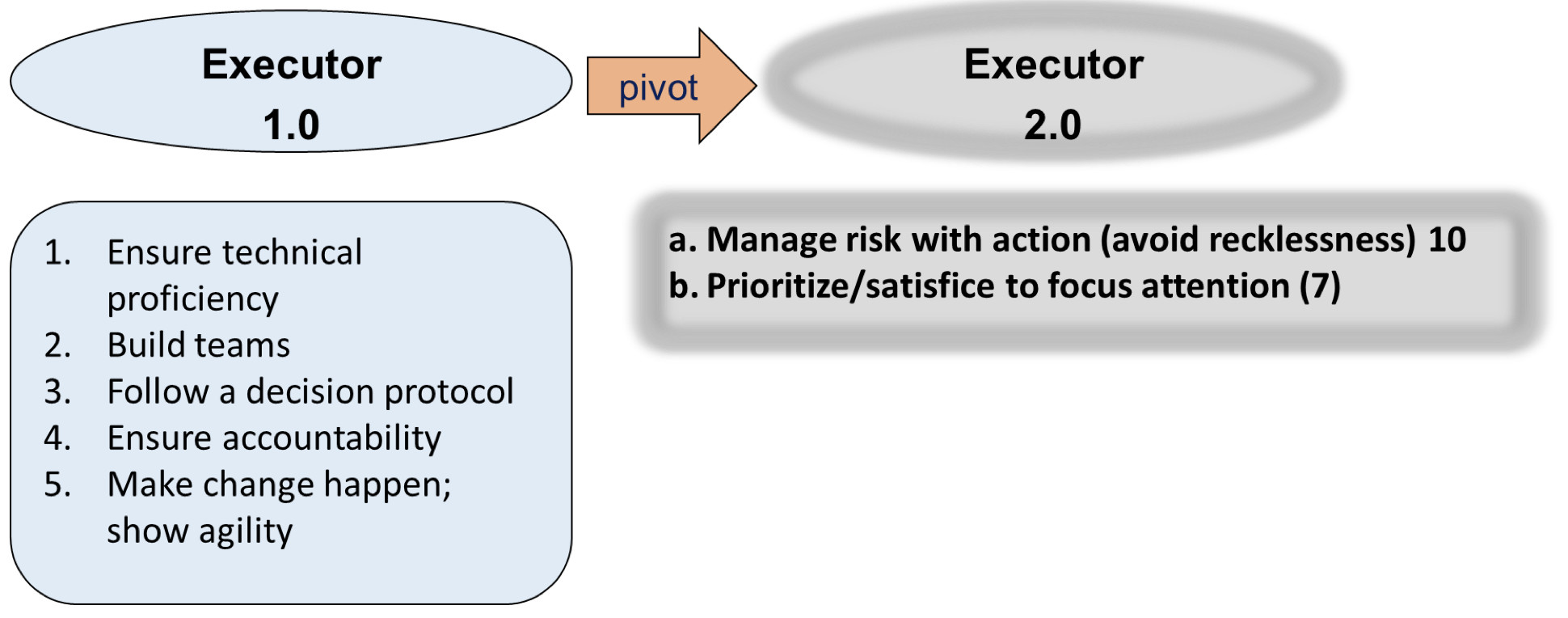
Talent Manager: Engage Today’s Talent
Talent Managers answer the question, “Who goes with us on our business journey?” Talent Managers know how to identify, build, and engage talent to get results now.
Employees today require skills and behavioral commitment to do their work, but increasingly they want to find emotional commitment as well. Leaders need to become meaning makers to help employees find meaning from their work. In addition, in a world of heightened transparency (e.g., harassment issues), leaders need to manage the unconscious biases that affect how work is done.
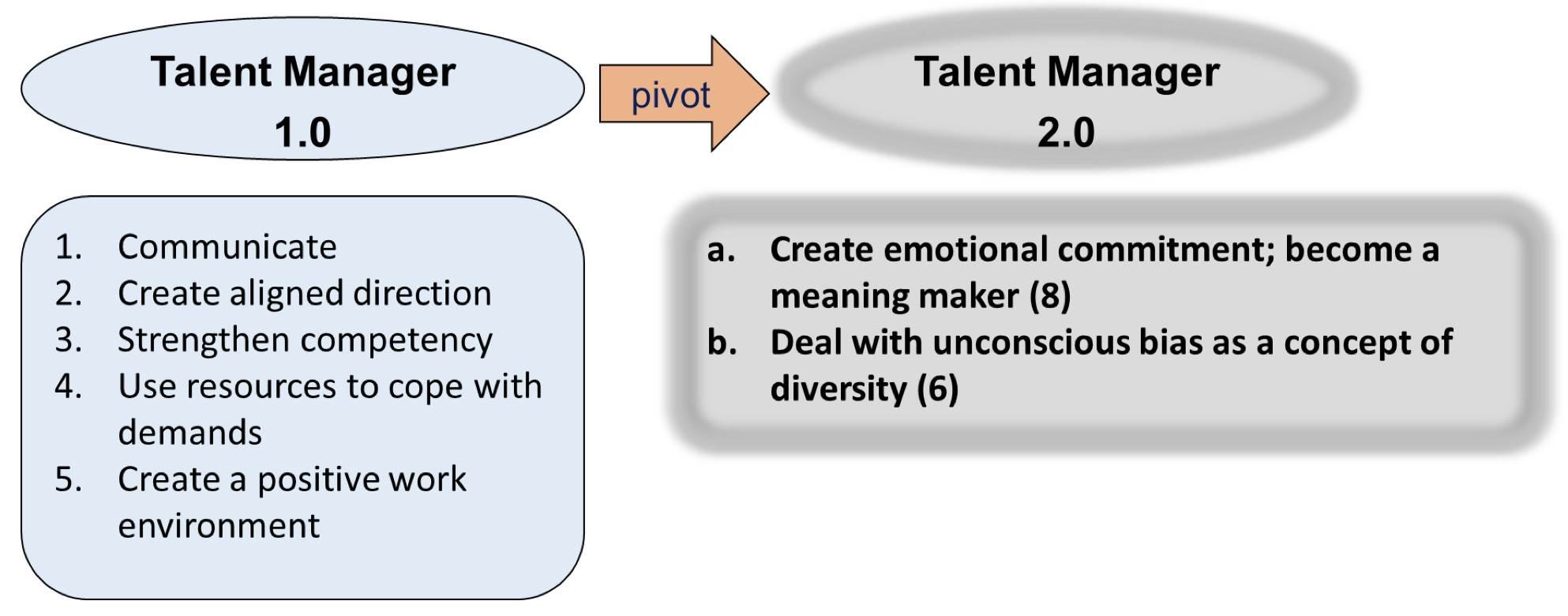
Human Capital Developer: Build the Next Generation
Human Capital Developers answer the question, “Who stays and sustains the organization for the next generation?” Talent Managers ensure shorter-term results through people while Human Capital Developers see that the organization has the longer-term competencies required for future strategic success. Current leaders now need to help emerging leaders craft a personalized career roadmap. This personalized career journey becomes even more important as baby boomers rapidly leave the work setting, leaving openings for emerging leaders to take over. Today’s leaders also need to shape the next generation of leaders by identifying and nurturing high potentials who meet future business requirements.
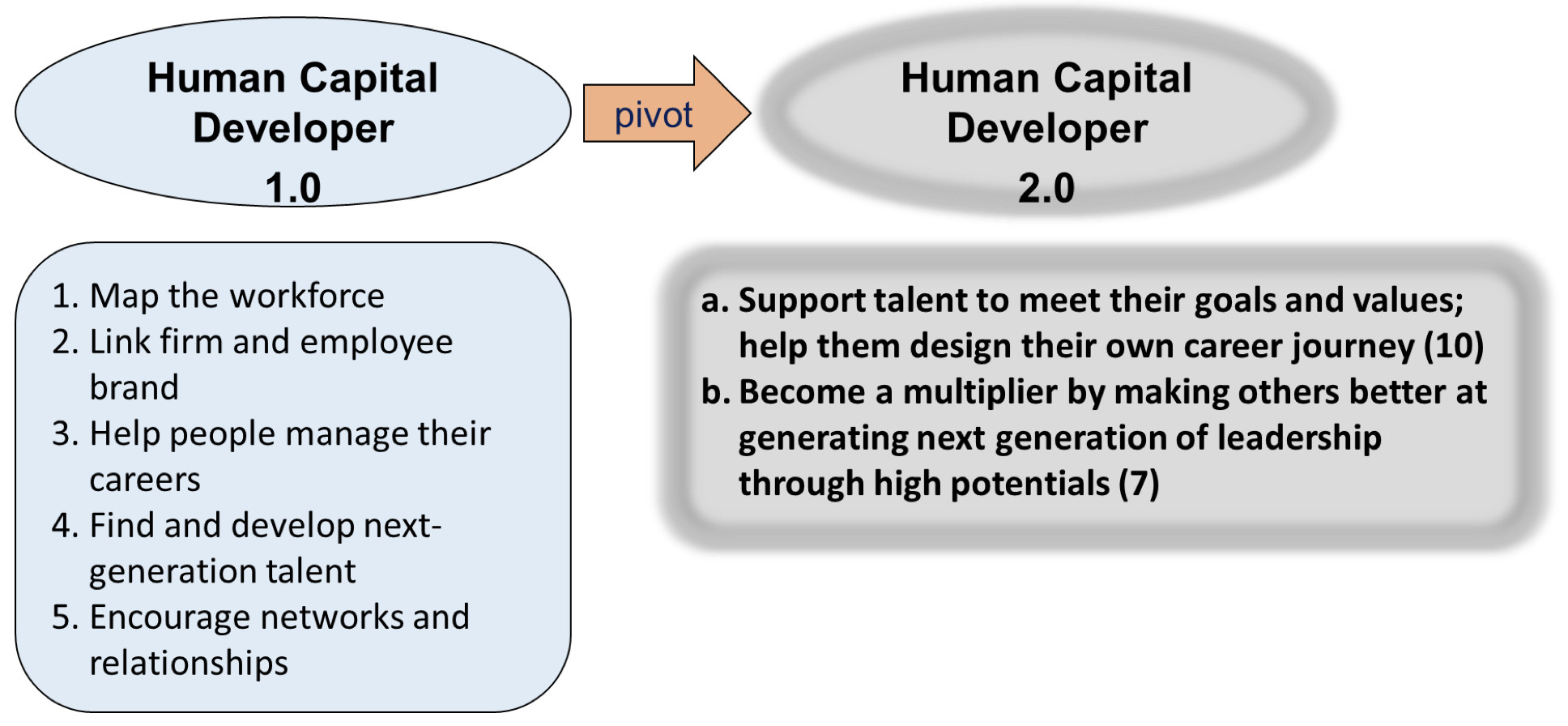
Personal Proficiency: Invest in Yourself
At the heart of the Leadership Code—literally and figuratively—is Personal Proficiency. Effective leaders cannot be reduced to what they know and do. Who they are as human beings has everything to do with how much they can accomplish with and through other people. Personally proficient leaders are individuals of high character who take care of themselves. We discovered that navigating paradox has become another crucial skill to having Personal Proficiency. This means that leaders need to negotiate both top-down and bottom-up work, customer focus and employee requirements, long-term and short-term actions, inclusivity to focus and diversity to broaden, and so forth. To navigate paradox, personally proficient leaders also need to be learners who act with courage and move quickly while having the ability to constantly adjust.
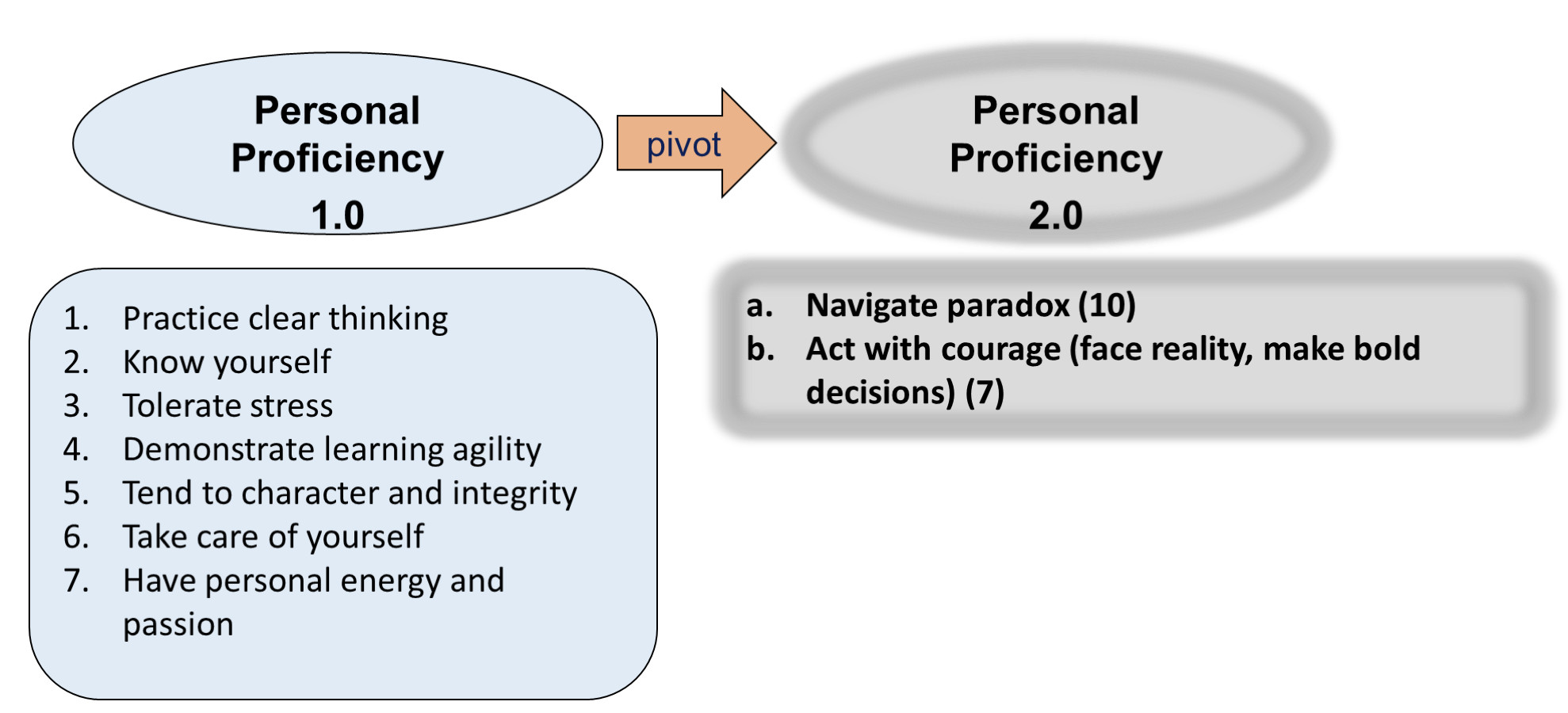
Implications of the Leadership Code 2.0
We are confident that what it takes to be an effective leader needs to pivot and evolve. We are not certain that we have perfectly defined the emerging leadership requirements, but we believe the evolving competencies in each of the five domains are at least part of today’s leadership success. We suggest the following actions in responding to this research.
- Application 1: Make personal leadership improvements. Ultimately, each individual leader is accountable for his or her improvement. Using the competencies in the Leadership Code 2.0, each leader can create a personal improvement plan. Which of the five code domains is a strength or weakness for you? What can you do to improve in each of the code domains?
- Application 2: Update your company’s leadership model. We have found that over 90 percent of companies already have a leadership competency model. It is helpful to update the specific competencies from the Leadership Code into your organization’s model.
- Application 3: Develop leaders by coaching. In coaching other leaders, it is important to help them recognize their personal strengths and areas to improve based on the Leadership Code 2.0.
- Application 4: Build leadership capability throughout your organization. We have identified that these Leadership Code 2.0 competencies are a foundation for enacting leadership capability.
So, what are the emerging leadership requirements we have missed? We encourage you to not simply reinforce what is already in the five Leadership Code 1.0 domains but focus on what’s new and next! Continue to evolve to meet the demands of a changing business context.
- - - -
To learn more about The RBL Group's Leadership and Talent Practice, please click here.




